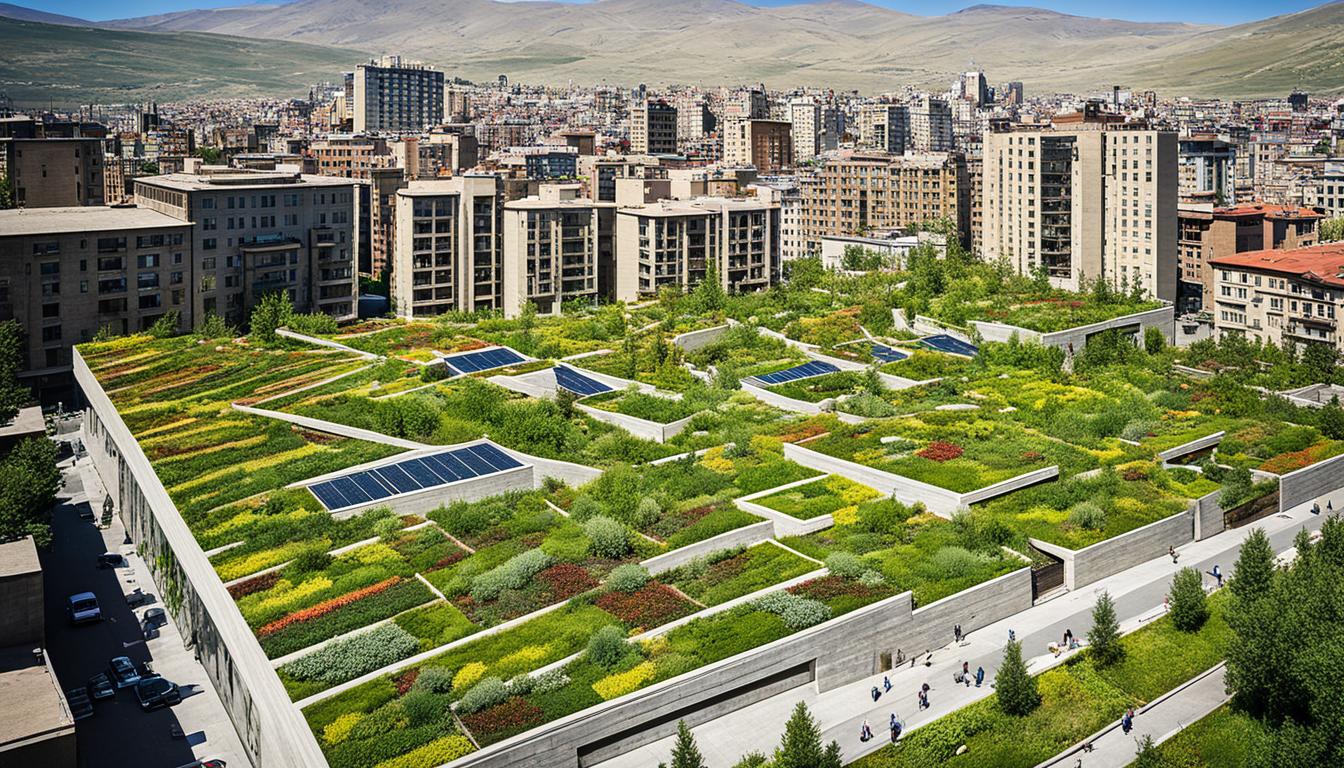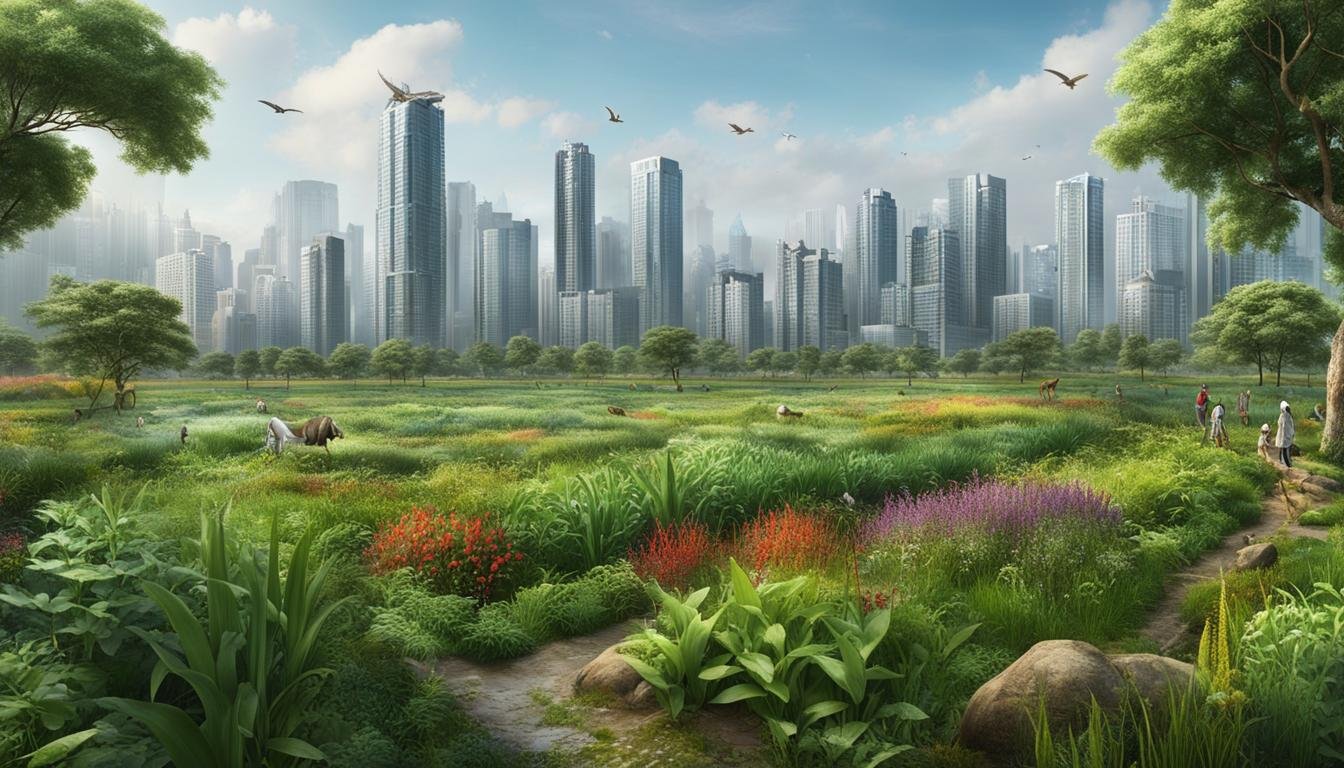Argentina Biodiversity and the Built Environment
Welcome to our exploration of Argentina’s remarkable biodiversity and its relationship with the built environment. Argentina is a country teeming with diverse animal and plant species, making it a treasure trove of ecological wonders. However, the delicate balance of this biodiversity is threatened by human activities such as deforestation and habitat destruction. In this article, we will delve into the importance of conservation efforts in protecting Argentina’s rich ecosystem and promoting sustainable development.
Key Takeaways:
- Argentina boasts remarkable ecological diversity, with over 1,000 bird species, 375 reptile species, and 300 mammal species.
- Protected areas such as national parks and reserves play a crucial role in preserving Argentina’s biodiversity.
- Human activities like deforestation, habitat destruction, and pollution pose significant threats to Argentina’s biodiversity.
- Argentina has implemented significant conservation initiatives and collaborates with international organizations to protect its biodiversity.
- Biodiversity is essential for the well-being of both the environment and human society, providing ecosystem services and economic benefits.
Exploring Argentina’s Ecological Diversity
Argentina is a country teeming with ecological diversity, boasting an impressive array of wildlife species and diverse ecosystems. From the Andes mountain range to the Pampas grasslands and the Atlantic Forest, Argentina offers a rich tapestry of natural wonders to explore.
One of the remarkable aspects of Argentina’s biodiversity is its wealth of bird species. With over 1,000 different bird species, it’s a paradise for birdwatchers and ornithology enthusiasts. From the vibrant plumage of the Andean flamingo to the majestic flight of the Andean condor, each winged creature adds to the kaleidoscope of avian life.
In addition to the rich birdlife, Argentina is also home to a wide variety of reptiles and mammals. The country is home to 375 reptile species, including the elusive green anaconda and the iconic Argentine black and white tegu. When it comes to mammals, Argentina offers a haven for wildlife, with 300 different species inhabiting its diverse landscapes. From the elusive puma to the adorable South American coati, there are plenty of unique and fascinating mammals to discover.
What makes Argentina’s biodiversity even more special is the presence of endemic species. These are species that are found exclusively in Argentina, making them unique and highly precious. The Andean condor mentioned earlier is one such endemic species. Its presence in the country’s mountainous regions is a testament to Argentina’s role as a sanctuary for diverse and irreplaceable wildlife.
Argentina’s Diverse Ecosystems
Argentina’s ecological diversity is also evident in its diverse ecosystems. The country’s topography includes towering mountains, vast grasslands, and lush forests, each hosting a distinct set of species.
The Andes mountain range dominates Argentina’s western border and is home to unique flora and fauna that have adapted to the high-altitude conditions. Majestic peaks, icy glaciers, and alpine meadows make the Andes a breathtaking landscape to explore and study. It is also a vital habitat for iconic species such as the Andean condor, the guanaco, and the Andean cat.
The Pampas grasslands, stretching across central Argentina, form one of the most extensive and fertile natural grasslands on Earth. This vast expanse supports a diverse range of wildlife, including the giant anteater, the marsh deer, and the maned wolf. The Pampas is also renowned for its spectacular birdlife, with numerous waterbirds and raptors inhabiting its wetlands and savannahs.
The Atlantic Forest, located in northeastern Argentina, is recognized as one of the world’s most biodiverse forests. Its unique combination of tropical and temperate features results in an incredible concentration of endemic species. The jaguar, the tapir, and the harpy eagle are just a few examples of the incredible wildlife found in this lush and enchanting forest.
| Ecosystem | Key Features | Notable Wildlife |
|---|---|---|
| Andes Mountain Range | Towering peaks, icy glaciers, alpine meadows | Andean condor, guanaco, Andean cat |
| Pampas Grasslands | Expansive grasslands, wetlands, savannahs | Giant anteater, marsh deer, maned wolf |
| Atlantic Forest | Tropical and temperate forest, high biodiversity | Jaguar, tapir, harpy eagle |
Protected Areas in Argentina
Argentina is committed to preserving its diverse ecosystems and safeguarding its rich biodiversity. This dedication is evident in the establishment of various protected areas throughout the country. These protected areas, including national parks, nature reserves, and wildlife refuges, play a vital role in conserving Argentina’s natural heritage and ensuring the survival of endangered species.
Preserving Biodiversity and Habitat
Protected areas serve as essential sanctuaries for threatened wildlife species and fragile ecosystems. They provide a safe haven where flora and fauna can thrive undisturbed by human activities. By designating specific regions as protected areas, Argentina aims to limit human disruption of sensitive habitats and preserve the delicate balance of nature.
Examples of Protected Areas in Argentina
Argentina boasts an impressive array of protected areas, each offering unique experiences and opportunities for exploration. Here are some notable examples:
- Nahuel Huapi National Park: Located in the Andes region, this national park is renowned for its stunning landscapes, including lakes, mountains, and forests. It is home to diverse wildlife, including the endangered Huemul deer.
- Iguazu National Park: Tucked away in the northeast, this UNESCO World Heritage site encompasses the awe-inspiring Iguazu Falls. The park is teeming with biodiversity, housing over 2,000 species of plants and a variety of iconic wildlife.
- Talampaya National Park: Situated in the heart of Argentina, this national park showcases breathtaking red cliffs, unique rock formations, and ancient cave paintings. It provides a haven for numerous bird species and native fauna.
Conservation and Tourism
Protected areas not only contribute to biodiversity conservation but also play a crucial role in promoting sustainable tourism. Visitors can immerse themselves in the beauty of Argentina’s natural landscapes while supporting local communities and eco-friendly practices. These experiences foster a deep appreciation for the importance of safeguarding protected areas for future generations.
“Protected areas are invaluable treasures that allow us to connect with nature and witness the wonders of Argentina’s wildlife and landscapes.”
– Conservationist Adriana González
Threats to Argentina’s Biodiversity
Argentina’s rich biodiversity is facing significant threats posed by various human activities. Deforestation, habitat destruction, and pollution are among the key challenges that endanger the country’s unique ecosystems and species.
Deforestation and Habitat Destruction
Deforestation in the Gran Chaco and the Atlantic Forest has resulted in the loss of critical habitats for numerous species. The clearing of land for agriculture, logging, and expansion of urban areas has disrupted the delicate balance of these ecosystems, pushing many species towards the brink of extinction.
Pollution and its Impact
Pollution, particularly in urban areas, further exacerbates the threats to Argentina’s biodiversity. Contaminated water bodies and air pollution negatively affect aquatic animals, wildlife, and vegetation, leading to the disruption of delicate ecosystems. The consequences of pollution can have far-reaching effects, impacting not only the organisms directly exposed but also those dependent on them for survival.
“Pollution, particularly in urban areas, further exacerbates the threats to Argentina’s biodiversity.”
The sequel follows an escalating cycle, as habitat destruction and pollution often go hand in hand. As human activity encroaches upon natural habitats, pollution levels inevitably increase, further intensifying the threats faced by Argentina’s unique and diverse ecosystems.
In order to address these pressing issues and protect Argentina’s invaluable biodiversity, it is crucial to implement effective conservation measures, promote sustainable land and resource management practices, and raise awareness about the importance of biodiversity preservation.
Conservation Initiatives in Argentina
Argentina is committed to protecting its biodiversity through significant conservation initiatives. These efforts aim to safeguard the country’s rich natural heritage and promote sustainable development. Let’s explore some key conservation initiatives in Argentina:
National System of Protected Areas
Argentina has established a robust National System of Protected Areas, comprising over 30 national parks and reserves. These protected areas serve as crucial habitats for a wide range of plant and animal species, ensuring their survival and promoting biodiversity conservation.

Biodiversity Laws
The government of Argentina has enacted biodiversity laws to regulate activities that may pose a threat to the country’s rich ecosystems. These laws provide frameworks for sustainable practices and help mitigate factors such as deforestation that can harm biodiversity.
International Collaborations
Argentina actively collaborates with international organizations to enhance its conservation efforts and share best practices for biodiversity protection. The country partners with entities like the Convention on Biological Diversity, exchanging knowledge and working towards global conservation goals.
Indigenous Conservation
Indigenous communities in Argentina play a crucial role in biodiversity conservation. They possess traditional knowledge and sustainable practices that have been passed down through generations. These communities actively engage in stewardship of their territories, contributing to the preservation of Argentina’s unique ecosystems.
Through the National System of Protected Areas, biodiversity laws, international collaborations, and indigenous conservation efforts, Argentina is taking significant strides in protecting its diverse natural heritage. These initiatives demonstrate the country’s commitment to preserving its ecosystems for future generations.
The Importance of Biodiversity for Argentina’s Future
Argentina’s biodiversity plays a crucial role in its ecological health and future economic growth. The diverse array of species and ecosystems provide a range of essential ecosystem services that sustain life and contribute to the well-being of both nature and human society.
One of the key ecosystem services provided by biodiversity is pollination. Bees and other pollinators play a vital role in the reproduction of flowering plants, including many food crops. Without them, the production of fruits, vegetables, and nuts would be severely impacted, leading to food scarcity and economic losses in the agricultural sector.
Another important service is soil fertility. Bacteria, fungi, and other microorganisms present in healthy soils contribute to nutrient cycling, decomposition of organic matter, and the formation of soil structure. These processes are essential for agricultural productivity and contribute to sustainable food production.
Biodiversity also aids in climate regulation, helping to mitigate the impacts of climate change. Forests and other natural habitats capture and store carbon dioxide, a greenhouse gas responsible for global warming. By preserving these habitats, Argentina contributes to global efforts to address climate change and reduce greenhouse gas emissions.
Furthermore, Argentina’s biodiversity supports various economic sectors. The country’s rich marine life, for example, sustains fishing industries, providing income and livelihoods for coastal communities. In addition, ecotourism thrives on the unique flora and fauna found in Argentina, attracting visitors from around the world and generating revenue for local economies.
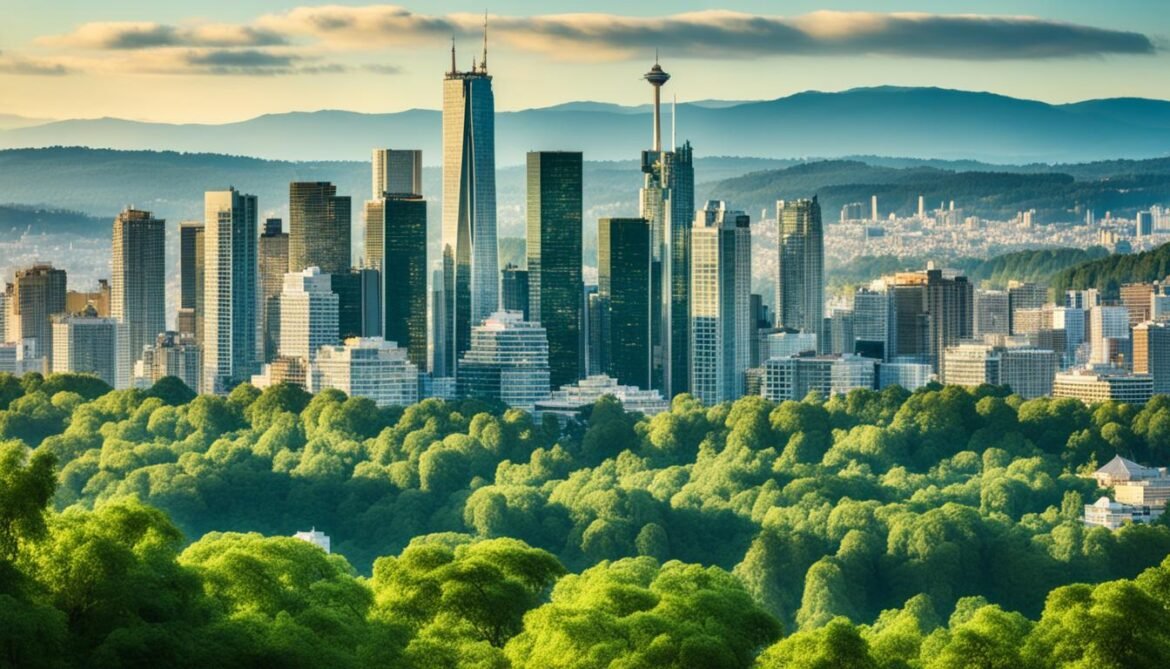
Conserving Argentina’s biodiversity is therefore of paramount importance. By protecting and restoring natural habitats, implementing sustainable land and water management practices, and promoting responsible tourism, Argentina can ensure the continued provision of ecosystem services and secure a sustainable future for both its environment and its people.
Argentina Built Environment
In Argentina, a strong emphasis is placed on sustainable practices within the built environment. The integration of urban agriculture, sustainable architecture, green building, and eco-friendly practices has become a cornerstone of the country’s commitment to environmental responsibility and creating a healthier, more sustainable future.
The Power of Urban Agriculture
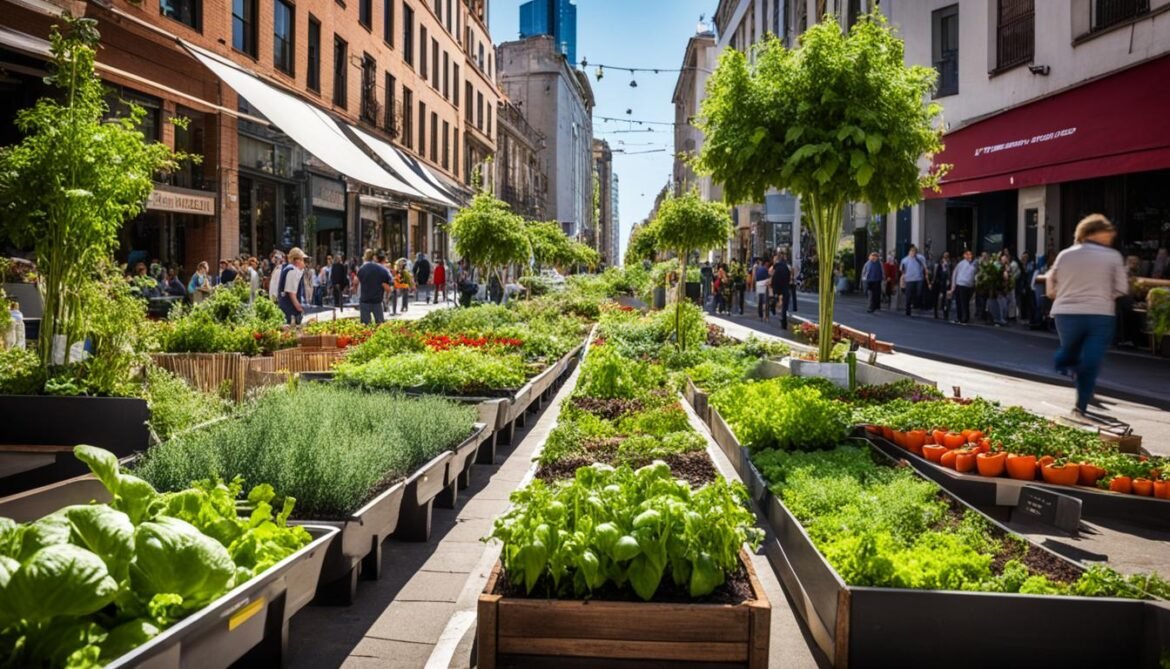
One of the key aspects of Argentina’s sustainable built environment is the promotion of urban agriculture. Through initiatives such as rooftop gardens, community allotments, and vertical farming, Argentina encourages the cultivation of food in urban areas. By growing food locally, the country reduces greenhouse gas emissions caused by long-distance food transportation, thus helping combat climate change. Moreover, urban agriculture fosters biodiversity by creating green spaces and promoting the integration of nature into the urban landscape.
Sustainable Architecture for a Greener Future
Argentina’s green building industry is playing a vital role in shaping the sustainable built environment. Through the use of eco-friendly materials, energy-efficient designs, and innovative technologies, the country is redefining the concept of sustainable architecture. From residential buildings to commercial structures and public spaces, Argentina’s commitment to sustainable architecture aims to minimize the environmental footprint of constructions and create healthier, more energy-efficient spaces.
Promoting Eco-Friendly Practices
Central to Argentina’s built environment strategies are eco-friendly practices that promote sustainability. These practices encompass various aspects, including energy conservation, waste management, water efficiency, and biodiversity preservation. By adopting eco-friendly practices, Argentina is reducing its ecological impact and actively contributing to global efforts to combat climate change.
“The integration of sustainable practices in Argentina’s built environment not only benefits the environment but also enhances the quality of life for its residents, promoting a healthier and more sustainable lifestyle.”
Benefits of Argentina’s Sustainable Built Environment
| Benefits | Description |
|---|---|
| Reduced carbon footprint | Sustainable practices lower greenhouse gas emissions, leading to a healthier environment and mitigating climate change. |
| Biodiversity preservation | The integration of nature and green spaces in urban areas fosters biodiversity and conservation efforts. |
| Energy efficiency | Sustainable architecture and eco-friendly practices minimize energy consumption, reducing reliance on fossil fuels. |
| Improved air and water quality | By implementing eco-friendly practices, Argentina aims to enhance the overall quality of air and water resources. |
| Enhanced well-being | A sustainable built environment promotes a healthier lifestyle, supporting physical and mental well-being. |
Argentina’s commitment to sustainable practices in the built environment is not only transforming the physical landscape but also inspiring other nations to embrace eco-conscious approaches to urban development. By prioritizing urban agriculture, sustainable architecture, green building, and eco-friendly practices, Argentina is paving the way for a greener future.
Discover Argentina’s Top Green Buildings for Sustainable Living
In Argentina, the commitment to sustainable development is exemplified by the country’s top green buildings. These architectural gems prioritize energy efficiency, utilize eco-friendly materials, and incorporate innovative green building design principles. By doing so, they actively contribute to reducing the environmental impact of the built environment and promoting sustainable living practices.
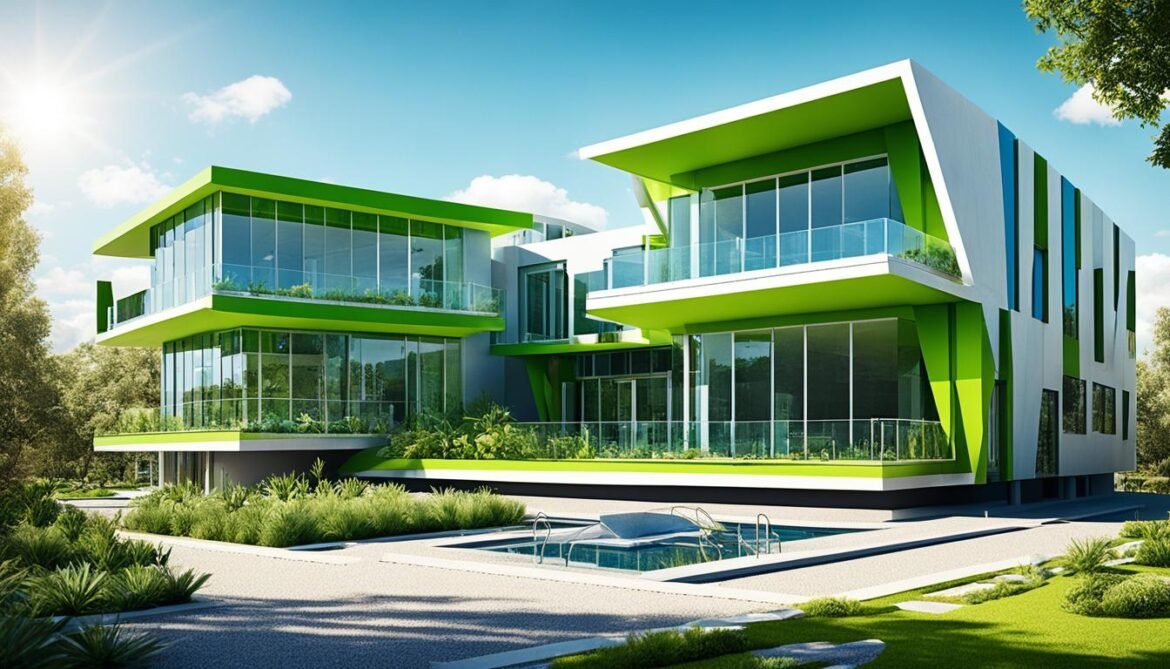
Argentina’s top green buildings serve as a shining example for other countries striving for sustainable development. Let’s take a closer look at some of these impressive structures:
“Argentina’s green building designs not only focus on aesthetics but also aim to harmonize with the environment, ensuring a sustainable future for generations to come.”
Visionary Tower: A Beacon of Energy Efficiency
Visionary Tower, located in Buenos Aires, showcases the epitome of energy efficiency. With its state-of-the-art insulation, solar panels, and intelligent lighting systems, the tower significantly reduces energy consumption and carbon emissions. Its innovative design optimizes natural light and ventilation, creating a comfortable and sustainable living space.
EcoPalace: A Showcase of Eco-Friendly Materials
EcoPalace, nestled in the heart of Cordoba, is celebrated for its extensive use of eco-friendly materials. The building incorporates sustainable timber, recycled steel, and non-toxic paints and finishes. These eco-friendly choices not only minimize the environmental impact during construction but also contribute to healthier indoor air quality for its occupants.
Nature’s Haven: Integrating Green Spaces
Nature’s Haven, situated in Mendoza, seamlessly integrates green spaces into its design. The building features vertical gardens, rooftop greenhouses, and a permeable ground surface that allows rainwater infiltration. This harmonious integration of nature within the built environment contributes to improved air quality, reduced urban heat island effect, and enhanced biodiversity.
Argentina’s top green buildings are leading the way towards a sustainable future by prioritizing energy efficiency, utilizing eco-friendly materials, and embracing innovative green building design principles. Their commitment to sustainable development sets an inspiring example for other countries striving to create a greener, more sustainable built environment.
| Building Name | Location | Key Features |
|---|---|---|
| Visionary Tower | Buenos Aires | Energy-efficient design, solar panels, intelligent lighting systems |
| EcoPalace | Cordoba | Use of eco-friendly materials, sustainable timber, recycled steel |
| Nature’s Haven | Mendoza | Integration of green spaces, vertical gardens, rooftop greenhouses |
Table: Argentina’s Top Green Buildings
Explore Green Building Argentina: A Sustainable Future Ahead
Green building practices in Argentina prioritize eco-friendly practices and responsible resource management. These practices not only minimize the environmental impact of the built environment but also contribute to sustainable tourism and outdoor recreation, promoting the sustainable use of natural resources.
Argentina’s commitment to green building ensures a sustainable future by creating spaces that enhance the well-being of residents and visitors while preserving the environment. By integrating eco-friendly practices, such as energy-efficient designs and the use of sustainable materials, Argentina’s green buildings exemplify the country’s dedication to sustainable development.
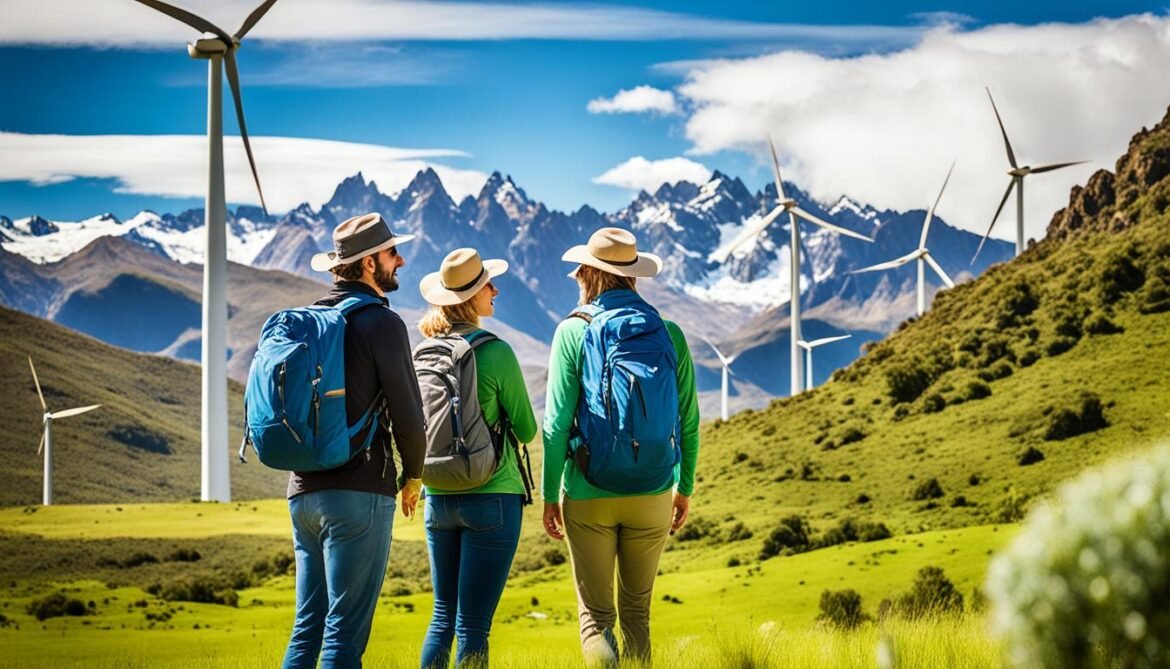
Benefits of Green Building in Argentina
Implementing eco-friendly practices in the construction industry has numerous benefits for Argentina and its future:
- Reduced environmental impact: Green buildings in Argentina employ energy-efficient technologies, renewable energy sources, and efficient water management systems, resulting in lower greenhouse gas emissions and reduced resource consumption.
- Sustainable tourism opportunities: With a focus on eco-friendly practices, green buildings promote sustainable tourism in Argentina. Tourists seeking environmentally responsible experiences can choose accommodations and recreational facilities that align with their values.
- Outdoor recreation spaces: Green buildings often incorporate green spaces and outdoor amenities, providing residents and visitors with opportunities for outdoor recreation, relaxation, and connection with nature.
- Resource conservation: Through responsible resource management, green buildings in Argentina contribute to the conservation of natural resources, such as water and energy. This supports long-term sustainability and helps mitigate the impacts of climate change.
- Economic benefits: Green building practices stimulate economic growth and job creation in Argentina. The construction and operation of green buildings require a specialized workforce, leading to employment opportunities in sustainable industries.
Argentina’s emphasis on green building demonstrates its commitment to a sustainable future, where eco-friendly practices and responsible resource management play a significant role in shaping the built environment.
“Green buildings are essential for promoting sustainable development in Argentina. By integrating eco-friendly practices into the construction industry, Argentina can protect the environment, support local communities, and provide sustainable tourism opportunities.”
– Environmental expert, Dr. María Alvarez
Examples of Sustainable Building Initiatives in Argentina
A number of sustainable building initiatives have been implemented in Argentina, showcasing the country’s commitment to green practices:
| Green Building Initiative | Description |
|---|---|
| Buenos Aires Ecological Court | A state-of-the-art judicial building in Buenos Aires that incorporates sustainable design elements, renewable energy systems, and efficient water management technologies. |
| Paseo del Bajo | A highway infrastructure project in Buenos Aires that incorporates green spaces, pedestrian-friendly amenities, and modern transportation systems, promoting sustainable urban development. |
| La Aldea Feliz | A sustainable housing development in Córdoba that focuses on energy efficiency, rainwater harvesting, and community engagement, creating a model for sustainable urban living. |
These initiatives showcase Argentina’s commitment to sustainable development and serve as models for the integration of eco-friendly practices in the built environment.
Argentina’s green building practices pave the way for a sustainable future, where the built environment enhances the well-being of its inhabitants and preserves the country’s natural resources. Through eco-friendly practices, resource management, and sustainable tourism opportunities, Argentina sets an example for other nations striving to create a more environmentally conscious and sustainable world.
Textured walls enclose Maricel’s House in central Argentina
Maricel’s House in central Argentina is a stunning example of sustainable architecture and responsible materials. The house features textured walls that not only add visual interest but also serve practical purposes. These walls are designed to regulate the internal temperature, providing natural insulation that reduces the need for artificial heating or cooling systems.
One of the key aspects of sustainable architecture is the use of responsible materials, and Maricel’s House embodies this principle. The walls are constructed using locally sourced materials, such as adobe and reclaimed wood, minimizing the carbon footprint associated with transportation. These materials are not only environmentally friendly but also contribute to the unique aesthetic of the house.
The innovative designs of Maricel’s House go beyond its textured walls. The entire structure is carefully integrated with the surrounding environment, blending seamlessly into the natural landscape. Large windows and strategic placement of skylights maximize natural light and ventilation, reducing the reliance on artificial lighting and air conditioning.
“Maricel’s House demonstrates how sustainable architecture can be both visually striking and environmentally responsible. By showcasing innovative designs that prioritize energy efficiency and responsible material use, this house sets a benchmark for future architectural projects in Argentina.”
In addition to its sustainable features, Maricel’s House incorporates elements of biophilic design, which incorporates natural elements into the built environment to enhance the well-being of occupants. The house is surrounded by lush gardens and incorporates green roofs that provide habitat for local flora and fauna.
Overall, Maricel’s House represents Argentina’s commitment to sustainable architecture and the integration of responsible materials and innovative designs. It stands as a testament to the country’s efforts in building structures that not only harmonize with nature but also prioritize the well-being of residents and the surrounding ecosystem.
| Key Features of Maricel’s House |
|---|
| Textured walls for natural insulation |
| Use of locally sourced materials |
| Innovative designs maximizing natural light and ventilation |
| Integration of biophilic design elements |

Rosario’s Urban Agriculture Program: A Model for Sustainable Development in Argentina
Rosario, Argentina, is leading the way in sustainable development through its award-winning urban agriculture program. This innovative initiative focuses on sustainable farming practices and the establishment of local markets, contributing to climate change mitigation and fostering community resilience.
The program’s primary objective is to grow food locally, reducing greenhouse gas emissions associated with long-distance food transportation. By promoting urban agriculture, Rosario reduces its carbon footprint while ensuring a steady supply of fresh produce for its residents. This localized approach to farming also encourages community engagement and empowerment, strengthening social bonds and enhancing food security.
Urban agriculture in Rosario goes beyond environmental benefits. It plays a vital role in promoting biodiversity by providing habitats for various species within the urban landscape. The preservation of green spaces within the city promotes ecological balance, essential for sustaining plant and animal life.
“The urban agriculture program in Rosario demonstrates how sustainable farming practices can transform urban areas into vibrant, self-sustaining ecosystems. By integrating nature into the city, we create a harmonious relationship between urban development, agriculture, and the environment,” says Maria Lopez, a local farmer.
This groundbreaking initiative also fosters local markets, supporting small-scale farmers and businesses. Rosario’s urban agriculture program creates opportunities for residents to access fresh, locally grown produce directly from farmers, strengthening the local economy and promoting sustainable consumption practices.
The impact of Rosario’s urban agriculture program extends beyond the city’s borders. By adopting sustainable farming practices and reducing their reliance on agrochemicals, farmers contribute to climate change mitigation. Sustainable agriculture practices, such as organic farming and permaculture, help sequester carbon, conserve water, and preserve soil health.
Rosario’s urban agriculture program serves as a model for other cities around the world. Its success demonstrates the potential for sustainable farming practices to address pressing urban challenges, such as food security, climate change, and community well-being. By embracing urban agriculture, cities can transform their landscapes, promote sustainable development, and create a more resilient future for all.
Benefits of Rosario’s Urban Agriculture Program:
- Promotes local food production, reducing greenhouse gas emissions from food transportation
- Fosters biodiversity by providing habitats for urban wildlife
- Strengthens community bonds and enhances food security
- Sustains local markets, supporting small-scale farmers and businesses
- Contributes to climate change mitigation through sustainable farming practices
- Serves as a model for other cities interested in sustainable development
| City | Program Focus | Key Achievements |
|---|---|---|
| Rosario | Urban Agriculture | Reduced greenhouse gas emissions, promoted local food production, enhanced community resilience |
| Barcelona | Green Roofs | Improved urban thermal regulation, reduced energy consumption, enhanced biodiversity |
| Portland | Community Gardens | Strengthened community bonds, increased access to fresh produce, promoted sustainable land use |
| Tokyo | Vertical Farming | Maximized food production in limited space, reduced environmental impact, increased food security |
Conclusion
Argentina’s biodiversity is a precious resource that must be protected to ensure sustainable development. Conservation efforts play a vital role in preserving Argentina’s unique and diverse ecosystems. By integrating sustainable practices into the built environment, such as green building and urban agriculture, Argentina can foster biodiversity and contribute to mitigating climate change.
Protecting Argentina’s biodiversity is essential for the well-being of both the environment and society. It enables the provision of crucial ecosystem services, such as pollination, which supports food production and agricultural industries. Additionally, Argentina’s commitment to sustainable development through the conservation of biodiversity generates economic benefits, including income from ecotourism.
Argentina’s sustainable initiatives, such as the establishment of protected areas and collaboration with international organizations, demonstrate the country’s dedication to preserving its natural heritage. Furthermore, the integration of sustainable practices in the built environment, such as using eco-friendly materials and designs, reduces the environmental footprint and promotes a healthier lifestyle for residents.
By prioritizing the conservation of Argentina’s biodiversity and embracing sustainable practices in the built environment, the country can create a harmonious relationship between nature and human development. Ensuring the preservation of Argentina’s rich biodiversity is crucial for a sustainable future and the well-being of current and future generations.




